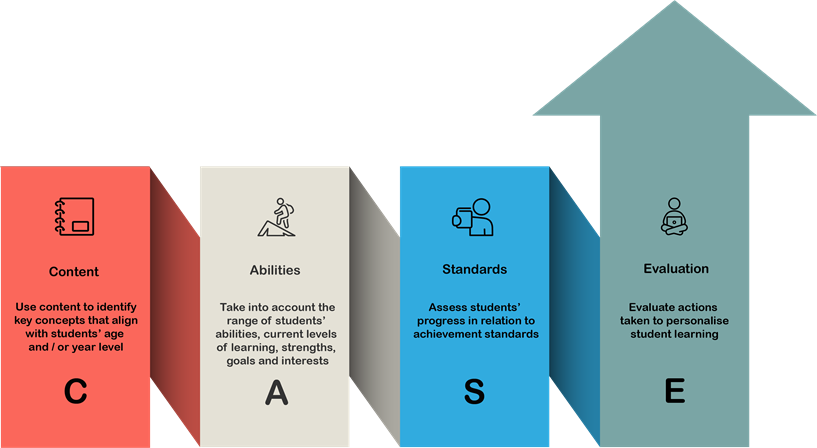By planning personalised learning for students, schools and teachers optimise learning experiences and maximise student engagement. The Australian Curriculum outlines a four‑step process that assists teachers to flexibly differentiate and personalise learning for students with diverse needs.
These are referred to as CASE steps (Content, Abilities, Standards, Evaluation) and incorporate the three dimensions of the Australian Curriculum:
- eight learning areas
- seven general capabilities and
- three cross-curriculum priorities.
The CASE steps can be used to plan for students with disability, gifted and talented students and English as an additional language or dialect (EAL/D) students.

Detailed description of diagram
Planning resources
Schools plan their curriculum and assessment programs to ensure what is taught informs how it is taught, how students are assessed, and how progress and learning is reported.
- NEW Class unit plan: Planning for adjustments (DOTX, 262.5 KB)
- Environmental adjustments (DOCX, 254.2 KB)
- Instructional adjustments (DOCX, 249.2 KB)
- UPDATED Student unit plan: Planning for adjustments (DOTX, 258.1 KB)
CASE: Content
When using a CASE steps approach for planning teaching and learning, teachers begin by looking at the learning area content that aligns with students' chronological age and year level.
Starting with this content ensures:
- purposeful development of age-appropriate teaching and learning programs
- rigorous programs that challenge and engage all students
- abundant opportunities for all students to progress.
Illustration of CASE: Content
CASE: Abilities
After considering the CASE Content of the age-appropriate learning area, schools incorporate CASE Abilities to further personalise the teaching and learning for students.
This is achieved by collaboratively adjusting teaching and learning programs to:
- draw on students' interests and abilities to inform age- and year-level learning area content
- use the general capabilities and/or cross-curriculum priorities to adjust the learning focus
- align age-equivalent learning area content with individual learning goals.
Illustration of CASE: Abilities
CASE: Standards
After using the CASE Content and CASE Abilities steps in the planning process, schools use CASE Standards to plan assessment in relation to achievement standards and individual learning goals.
Teachers use a range of strategies to monitor and assess individual student achievement and progress.
The requirements for assessment and reporting may differ across the State, Catholic and Independent sectors in Queensland. Schools follow sector-specific policy and guidelines in this area.
Illustration of CASE: Standards
CASE: Evaluation
After using the Content, Abilities and Standards steps, teachers review actions through CASE Evaluation.
Teachers evaluate and respond to the impact of teaching plans, strategies and resources used to differentiate and personalise learning in consultation with the student, their parents/carers and other professionals.
Reviewing planned adjustments is an important part of this step and supports teachers and schools in following legislative requirements of the Disability Discrimination Act 1992 (Cwlth) and the Disability Standards for Education 2005 (Cwlth).
Evaluation of implemented strategies provides opportunity to acknowledge successes and determine whether alternative personalised learning strategies are required to ensure that the student progresses.


